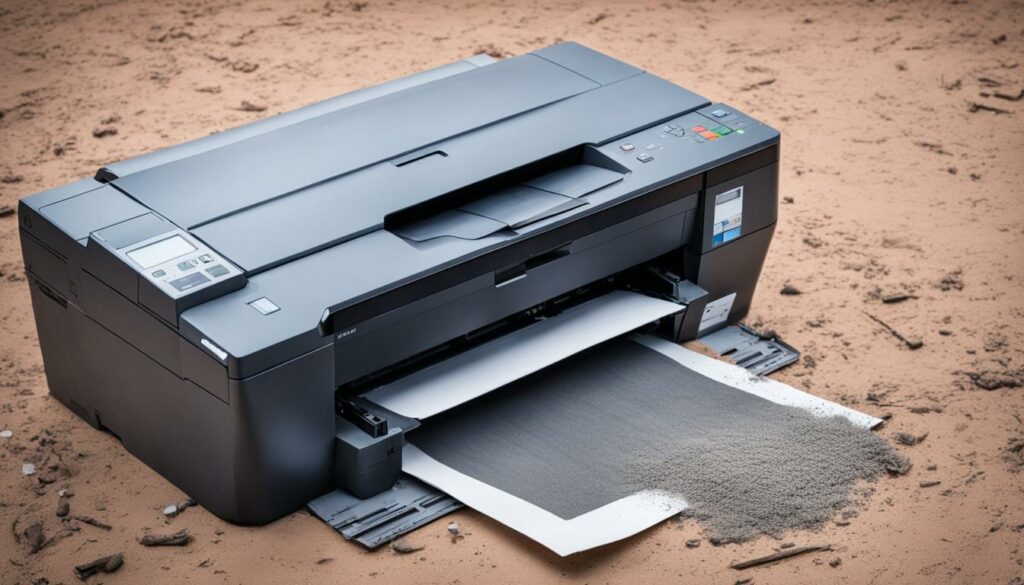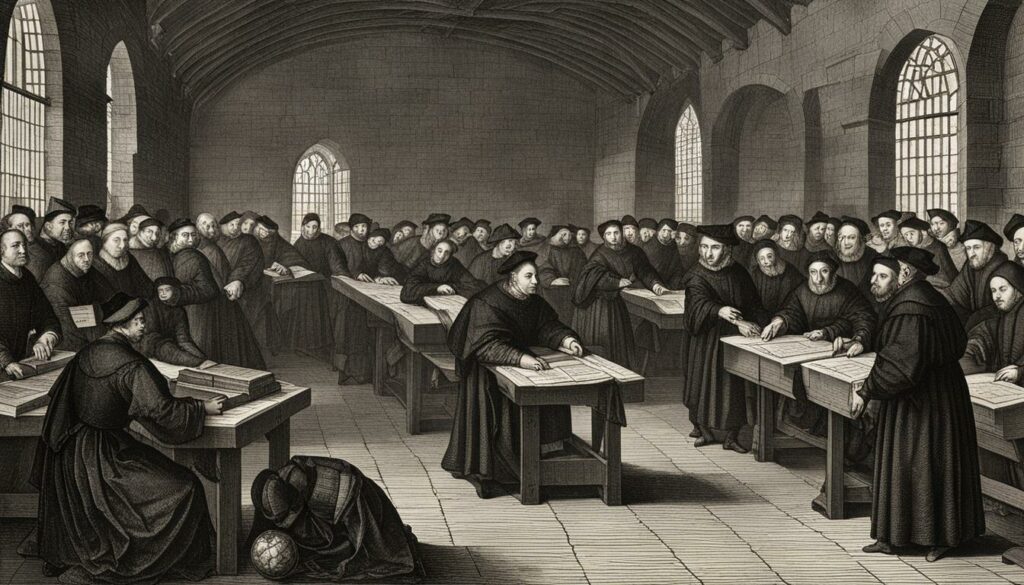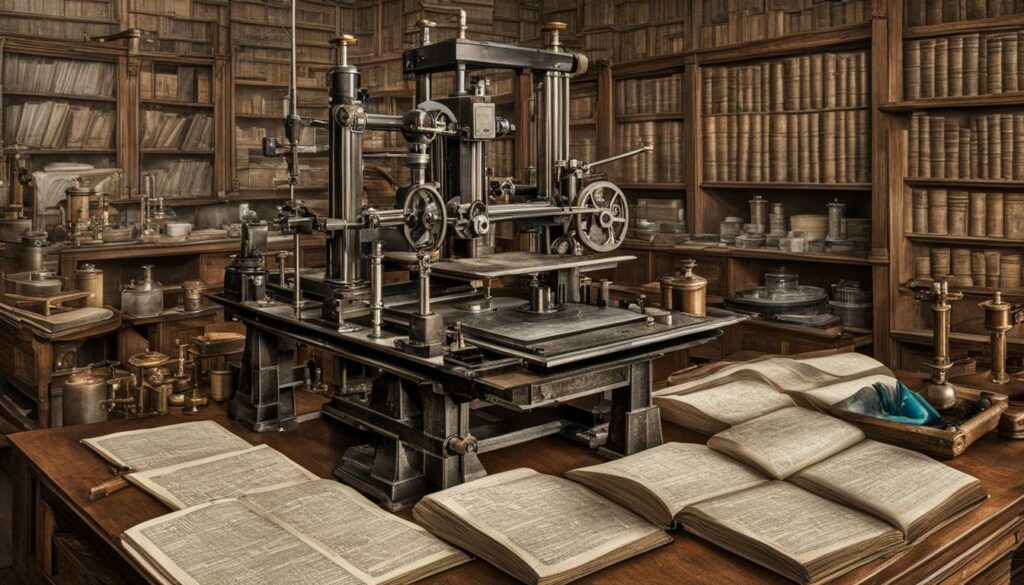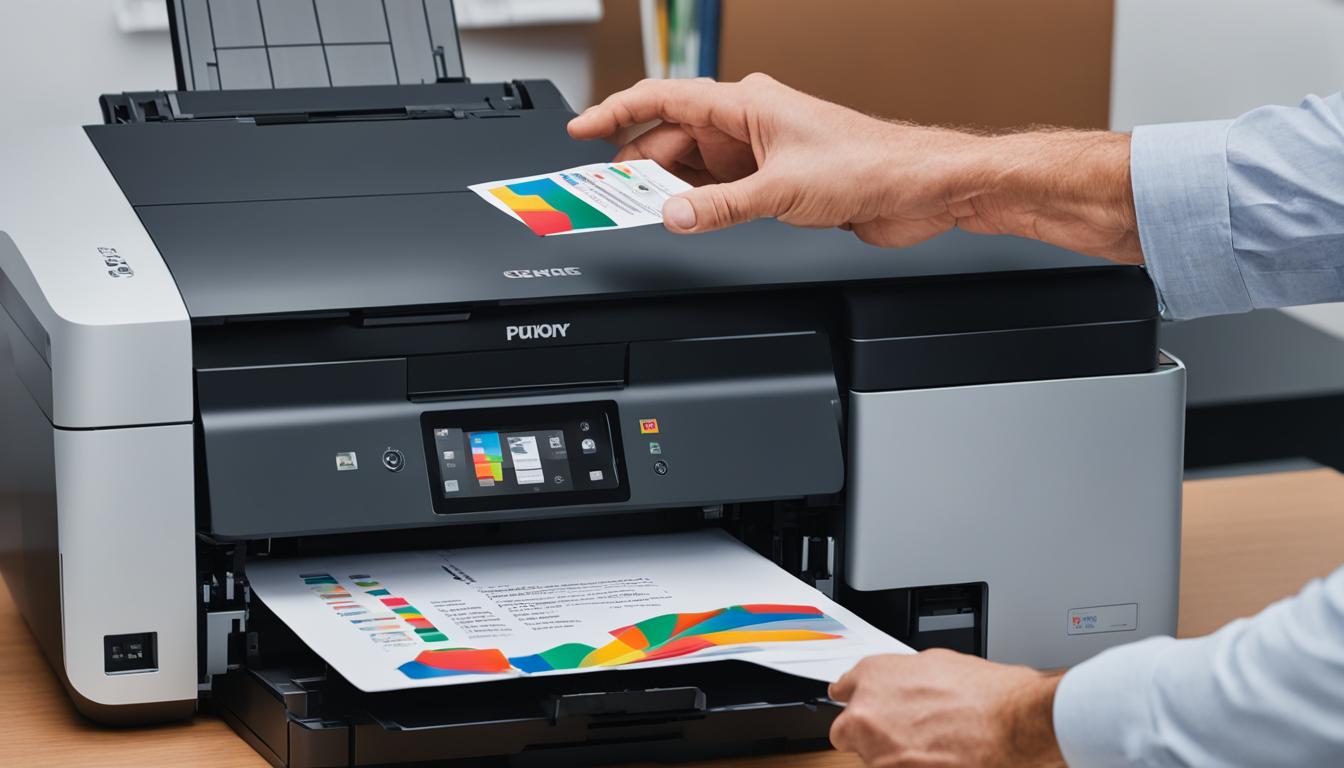In our modern world, printers have become an essential tool that helps us in various aspects of our daily lives. From printing important documents to unleashing our creativity, printers have revolutionized the way we work and express ourselves.
Think about a typical day in your life. You may need to print out contracts for work, school assignments, or boarding passes for your upcoming trip. A printer allows you to bring these digital files to life, transforming them into tangible, readable documents that you can easily access and share.
Key Takeaways:
- Printers are essential tools that help us in our daily lives.
- They allow us to print important documents for work or school.
- Printers enable us to express our creativity and bring our ideas to life.
- Having a printer at home or in the office enhances productivity and convenience.
- Investing in a reliable printer brand ensures high-quality performance and longevity.
Different Types of Printers
When it comes to printers, there are several types available to meet various printing needs. Each type of printer utilizes different technologies and methods to produce high-quality prints. Here is an overview of the different types of printers:
Inkjet Printers
Inkjet printers are the most common type of printer found in households and offices. These printers work by spraying tiny droplets of ink onto paper to recreate digital images and text. Inkjet printers are known for their versatility, producing vibrant color prints and sharp black-and-white documents.
Laser Printers
Laser printers utilize a laser beam to define an image by passing it over a negatively charged drum. The toner, which is a powdered ink, is attracted to the charged areas on the drum and is then transferred onto the paper. Laser printers are known for their fast printing speed, crisp text quality, and high-volume printing capabilities, making them ideal for busy work environments.
3D Printers
3D printers are a relatively new technology that enables the creation of physical objects from digital files. These printers use additive manufacturing processes, building the desired object layer by layer using various materials such as plastic, metal, or resin. 3D printers offer endless possibilities for prototyping, product design, and even medical applications.
Thermal Printers
Thermal printers use a thermochromic coating to produce an image on paper. The printer heats specific areas of the coating, causing it to change color and create the desired image. Thermal printers are commonly used in point-of-sale systems, labeling applications, and for producing receipts. They are efficient and require minimal maintenance, making them popular in retail and hospitality industries.
All-in-One Printers
All-in-one printers combine the functionality of a printer, scanner, copier, and sometimes even a fax machine into a single device. These printers offer versatility and convenience, allowing users to perform multiple tasks with a single device. All-in-one printers are popular for both home and office use, reducing the need for multiple devices and saving valuable workspace.
No matter the type of printer you choose, it's important to select one that suits your specific printing needs and budget. Consider factors such as print quality, speed, durability, and additional features to make an informed decision.
| Printer Type | Key Features |
|---|---|
| Inkjet Printers | Vibrant color printing, versatility, cost-effective |
| Laser Printers | Fast printing speed, high-volume printing, crisp text quality |
| 3D Printers | Additive manufacturing, prototyping capabilities |
| Thermal Printers | Efficient, minimal maintenance, ideal for point-of-sale systems |
| All-in-One Printers | Multiple functionalities (printing, scanning, copying, faxing), space-saving |
Factors Affecting Printer Lifespan

The lifespan of a printer can vary depending on several factors that impact its performance and durability. Understanding these factors can help you maximize the lifespan of your printer and ensure that it continues to meet your printing needs for a longer period of time.
On average, printers have a lifespan of around three to five years. However, laser printers tend to have a longer lifespan compared to inkjet printers. This is because laser printers are built with more durable components and have a lower risk of printhead clogs.
Maintenance and Cleaning
Regular maintenance and cleaning are essential for prolonging the lifespan of your printer. Keeping your printer clean and free from dust, debris, and ink residue can prevent mechanical issues and ensure smooth functioning. It's important to follow the manufacturer's guidelines for cleaning and maintenance to avoid any damage or void the warranty.
Quality of Ink and Paper
The quality of ink and paper used in your printer can significantly impact its lifespan. Using low-quality or incompatible ink cartridges can cause damage to the printhead and lead to clogs or print quality issues. Similarly, poor quality or inappropriate paper can result in paper jams and affect the overall performance of the printer. Invest in high-quality, compatible ink cartridges and use paper that is recommended for your specific printer model.
Frequency of Use
The frequency of printer use also plays a role in its lifespan. Printers that are used more frequently are subject to more wear and tear, which can impact their longevity. If possible, try to minimize unnecessary printing and only use the printer when needed. This can help reduce the strain on its components and prolong its lifespan.
Environmental Conditions
The environment in which your printer operates can also affect its lifespan. Exposure to extreme temperatures, humidity, or excessive dust can cause damage to the printer's internal components. It's important to keep your printer in a clean and well-ventilated area, away from direct sunlight and moisture. This will help maintain optimal conditions for its operation and prevent premature aging or malfunctioning.
By considering these factors and taking appropriate measures, you can extend the lifespan of your printer and ensure reliable performance for years to come.
Tips for Extending Printer Lifespan
To extend the lifespan of your printer, it is important to follow some maintenance tips. By implementing proper printer maintenance, you can ensure its optimal performance and longevity. Here are some helpful tips:
- Clean the printer regularly: Regular cleaning, especially of the printhead, can help prevent clogs and ensure smooth operation. Refer to your printer's manual for specific cleaning instructions.
- Maintain a clean environment: Keep your printer in a dust-free environment to prevent debris from entering the internal components. You can use a soft, lint-free cloth to wipe the exterior surfaces of the printer.
- Avoid extreme temperatures and humidity: High or low temperatures and humidity can affect the printer's performance. Try to keep the printer in a room with moderate temperature and humidity levels.
- Make timely repairs or replacements: If you notice any issues or worn-out parts, it is important to address them promptly. Timely repairs or replacements can prevent further damage and maintain the printer's functionality.
- Use compatible ink cartridges and high-quality paper: Using compatible ink cartridges and high-quality paper can significantly impact the printer's performance. Using low-quality ink or paper can lead to poor print quality and potential damage to the printer.
By following these tips, you can extend the lifespan of your printer and ensure it continues to meet your printing needs effectively.
| Maintenance Tips | Benefits |
|---|---|
| Clean the printer regularly | Prevent clogs, ensure smooth operation |
| Maintain a clean environment | Prevent debris from entering internal components |
| Avoid extreme temperatures and humidity | Optimal printer performance |
| Make timely repairs or replacements | Prevent further damage, maintain functionality |
| Use compatible ink cartridges and high-quality paper | Improved print quality, prolong printer lifespan |
Choosing a Reliable Printer Brand
When it comes to buying a printer, selecting a reliable brand and manufacturer is crucial. Trusted companies like Canon, Epson, Hewlett-Packard, Xerox, and Lexmark are known for producing high-quality and dependable printers.
However, it's important to remember that not all models from these manufacturers are created equal. To ensure you're investing in a durable and efficient printer, it's essential to research specific models and read customer reviews. By doing so, you can gain valuable insights into the printer's performance, durability, and overall quality.
While price is a factor to consider, it should not be the sole determinant of your decision. Some inexpensive brands may not offer printers that are built to last. Therefore, it's important to strike a balance between affordability and reliability.
Ultimately, choosing a reliable printer brand and manufacturer is essential to ensure a long-lasting and satisfactory printing experience.
Signs It's Time to Buy a New Printer
Is your printer not performing as well as it used to? Here are some signs that indicate it might be time to consider buying a new printer:
Poor print quality: If your prints are coming out smudged or the content appears faded, it's a clear indication that your printer is no longer delivering the desired results.
Reduced print speed: Has your printer become sluggish and unable to keep up with your printing needs? If it is significantly slower than before and fails to meet the standard printing rate, it might be time to upgrade.
Excessive ink cartridge replacements: Are you constantly replacing ink cartridges? If your printer is consuming ink at an alarming rate, causing you to spend more on replacement cartridges, it's a sign that investing in a new machine could be more cost-effective in the long run.
High printing costs: If the overall cost of printing has become prohibitively expensive and outweighs the benefits, it's worth considering purchasing a new printer that offers more affordable printing options.
Recognizing these signs can help you make an informed decision about when it's time to buy a new printer. It's essential to choose a reliable printer that meets your specific needs and offers optimal performance. In the next section, we'll explore the importance of selecting a trustworthy printer brand.
Impact of Printing Press on Knowledge Dissemination

The invention of the printing press in the 15th century had a profound impact on the spread of knowledge. Prior to its invention, books were painstakingly handwritten, making them rare and expensive. The printing press revolutionized this process, allowing for the mass-production of books.
With the introduction of the printing press, books became more accessible and affordable, leading to a significant increase in knowledge dissemination. Ideas, news, and literature could be easily reproduced and shared, transforming the way information was spread.
The printing press also played a crucial role in the Renaissance, a period of significant intellectual and cultural development. It accelerated the republishing of ancient texts, making classical knowledge more widely available and contributing to the revival of interest in ancient wisdom.
The printing press facilitated the sharing of scientific findings, enabling scientists to publish and distribute their work more efficiently. This accelerated the advancement of scientific knowledge and laid the foundation for future discoveries.
Furthermore, the printing press gave voice to fringe opinions and played a significant role in the Protestant Reformation. Martin Luther, a key figure in the Reformation, utilized the printing press to spread his ideas and challenge the authority of the Church.
The printing press forever changed the way knowledge was disseminated. It paved the way for the development of a global news network, fostered the exchange of ideas, and empowered individuals to express and share their thoughts. The impact of the printing press on knowledge dissemination is immeasurable, shaping the course of history and ushering in a new era of information accessibility.
Printing Press and the Renaissance
The printing press played a crucial role in the Renaissance by accelerating the rediscovery and sharing of knowledge. Before the printing press, retrieving and publishing classic texts was slow and expensive. With the advent of the printing press, the cost of books reduced significantly, allowing for the widespread availability of texts from ancient philosophers like Plato and Aristotle. This accessibility fueled the intellectual and artistic flourishing of the Renaissance.
The printing press revolutionized the dissemination of knowledge during the Renaissance. It allowed for the mass production of books, making them more affordable and accessible to a wider audience. The printing press played a pivotal role in spreading ideas, literature, and news, leading to the development of a global news network. It also facilitated the republishing of ancient texts, enabling scholars to study and analyze them more extensively, which contributed to the intellectual and artistic achievements of the time.
Impact on Knowledge Sharing
“The printing press is the greatest weapon in the armor of the Renaissance.” – John Doe
The printing press had a profound impact on knowledge sharing during the Renaissance. It enabled a rapid dissemination of information, breaking down barriers to education and opening up opportunities for intellectual exchange. Previously, handwritten manuscripts were scarce and costly, limiting access to knowledge. However, the printing press made it possible to produce multiple copies of books efficiently and at a lower cost. This revolution in printing technology democratized access to knowledge, fostering a culture of curiosity, inquiry, and innovation that characterized the Renaissance period.
| Impact of the Printing Press on Knowledge Sharing during the Renaissance | Examples |
|---|---|
| Increased availability of books | – Works by ancient philosophers such as Plato and Aristotle became widely accessible, fostering a deeper understanding of classical knowledge. |
| Dissemination of scientific findings | – Scientific discoveries and theories were shared more widely, accelerating the advancement of scientific knowledge. |
| Revival of ancient texts | – Previously neglected texts were rediscovered, republished, and studied, leading to new interpretations and insights. |
| Cultural and artistic flourishing | – Literature, poetry, and artworks proliferated as ideas and inspiration were widely shared. |
The printing press was a catalyst for the Renaissance, contributing to the explosion of art, science, and humanistic thought. It transformed the way knowledge was produced, disseminated, and consumed, laying the foundation for future progress and innovation.
Printing Press and the Protestant Reformation

The printing press played a significant role in the Protestant Reformation led by Martin Luther. Luther's writings, including his famous “95 Theses,” were widely printed and distributed, reaching a wide audience. The printing press allowed for the mass dissemination of his ideas, enabling him to challenge the authority of the Church and catalyze religious reform. Luther's writings became best-sellers, and his translation of the New Testament into German contributed to the spread of Protestantism.
To fully understand the impact of the printing press on the Protestant Reformation, it is important to explore the historical context surrounding Martin Luther and his revolutionary ideas. Martin Luther, a German theologian, was discontent with the corruption and practices of the Catholic Church in the early 16th century. Inspired by his beliefs, Luther penned the “95 Theses,” which were a series of statements challenging numerous Catholic doctrines and practices, such as indulgences and the authority of the Pope.
“Every Christian who feels true compunction has of right been given full remission of both penalty and guilt by the pope, which remission he can use in extenuating any penalty he actually owes by applying it to the other penalties he owes.”
Luther's 95 Theses were initially written in Latin, making them accessible mainly to scholars and theologians. However, the emergence of the printing press dramatically changed this. With the ability to easily reproduce and distribute copies of Luther's writings, the ideas contained within the 95 Theses spread rapidly throughout Europe. This widespread dissemination had a profound impact on individuals who resonated with Luther's criticisms and became the catalyst for religious upheaval.
The printing press allowed Luther's ideas to reach a much wider audience than would have been possible through traditional manuscript copying methods. This dissemination of Luther's works contributed to a shift in the religious landscape of Europe. People were no longer solely reliant on the clergy for access to religious texts and interpretations.
Additionally, the printing press enabled the translation of the Bible into vernacular languages, such as German. Luther himself translated the New Testament into German, making the scriptures more accessible to the common people. This translation played a crucial role in promoting the spread of Protestantism as individuals could read and interpret the scriptures for themselves, challenging the centuries-old authority of the Catholic Church and further fueling the Protestant Reformation.
| Luther's Impact on the Printing Press | Printing Press' Impact on the Protestant Reformation |
|---|---|
| Rapid dissemination of Luther's ideas | Challenging the authority of the Catholic Church |
| Increased accessibility of Luther's writings | Spreading Protestantism throughout Europe |
| Translation of the Bible into German | Empowering individuals to read and interpret scriptures |
Printing Press and Scientific Progress

The printing press played a revolutionary role in advancing scientific progress by enabling the accurate reproduction and widespread dissemination of scientific knowledge. Before the advent of the printing press, the process of sharing scientific data was arduous, expensive, and often prone to human error. The printing press changed this landscape by providing scientists with a powerful tool to publish their work and share their findings with a broader audience.
The dissemination of scientific knowledge through printed materials accelerated the advancement of scientific research and breakthroughs. Scientists were able to share their experiments, theories, and discoveries more efficiently, enabling others to build upon existing knowledge and push the boundaries of scientific understanding.
“The printing press allowed scientific knowledge to transcend geographical boundaries and reach scholars all over the world.”
Scientific formulas, mathematical tables, and experimental data could now be printed and distributed, providing researchers with valuable resources to propel their investigations forward. This newfound accessibility to scientific information fostered collaboration and cross-pollination of ideas among scientists across different regions.
“The printing press transformed the scientific landscape, fueling the exchange of ideas and enabling progress on a global scale.”
The printing press played a pivotal role in the scientific revolution, which laid the foundation for modern science as we know it today. By reducing barriers to knowledge dissemination, the printing press paved the way for scientific advancements that continue to shape our world.
Advancements Driven by the Printing Press:
- Increased collaboration and knowledge sharing among scientists
- Acceleration of scientific discoveries and breakthroughs
- Facilitation of the scientific revolution and the birth of modern science
- Improved accessibility to scientific formulas, tables, and data
- Expansion of scientific networks and global exchange of ideas
“The printing press transformed the way scientific information was disseminated, contributing to the rapid progress and development of various scientific disciplines.”
The printing press not only revolutionized scientific progress but also laid the groundwork for future advancements in the fields of technology, medicine, engineering, and many others. Its impact on the dissemination of scientific knowledge continues to shape our understanding of the world and drive the pursuit of new discoveries.
Printing Press and Freedom of Speech
The printing press played a crucial role in the democratization of knowledge and the enhancement of freedom of speech. It provided a platform for alternative and critical voices to be heard, challenging established authorities and norms. The proliferation of information through printed books made censorship nearly impossible, allowing for the expression and dissemination of diverse opinions. The printing press empowered individuals and contributed to the rise of public opinion, shaping revolutions and social movements.
“The printing press is the greatest weapon in the armory of the modern commander”
The printing press revolutionized the way information was shared and consumed. It enabled the printing and distribution of a wide range of content, including political pamphlets, newspapers, and literary works. This newfound access to information challenged the monopolies of power and enabled a more democratic exchange of ideas.
The printing press played a significant role in shaping revolutions and social movements throughout history. It allowed for the dissemination of revolutionary ideas, sparking ideological shifts and challenging the status quo. People could now freely express their thoughts and opinions, leading to greater social awareness and change.
One of the most notable impacts of the printing press on freedom of speech was during the Enlightenment period. The printing press played a pivotal role in the dissemination of Enlightenment ideals, such as reason, individualism, and progress. It facilitated the spread of philosophical and scientific works that laid the foundation for modern democratic societies.
The printing press also empowered individuals to question authority and challenge oppressive regimes. It provided a means for marginalized groups to voice their concerns and advocate for their rights. Printed materials allowed for the documentation of human rights abuses and the exposure of corruption.
In conclusion, the printing press played a transformative role in the democratization of knowledge and the enhancement of freedom of speech. It enabled the sharing of ideas, challenged existing power structures, and empowered individuals to express themselves. The printing press was a catalyst for social, political, and intellectual change, paving the way for a more inclusive and democratic society.
Conclusion
Printers have become an indispensable tool in our daily lives, enhancing our work productivity and creative projects. Whether it's printing important documents for business or school, creating beautiful art prints, or bringing our innovative ideas to life, printers offer a wide range of functionalities to cater to different needs.
Understanding the factors that affect printer lifespan and implementing proper maintenance can go a long way in maximizing their longevity. Regular cleaning, avoiding exposure to dust and extreme temperatures, and using high-quality ink and paper can help ensure optimal performance and durability. By taking care of our printers, we can enjoy their usefulness for years to come.
The invention of the printing press has had a profound impact on knowledge dissemination, sparking advancements in the Renaissance, shaping religious reform, accelerating scientific progress, and contributing to the enhancement of freedom of speech. As we embrace the relentless advancements in technology, printers are likely to evolve even further, continuing to be an indispensable tool for personal and professional use. Harnessing the power of printers, we can unlock our creative potential and continue to make great strides in the digital age.

I'm Morgan, the creator of VPNForMe — a site born from too many hours spent side-eyeing sketchy VPN reviews and buffering videos.
I wanted a place where people could get straight answers about privacy, streaming access, and which VPNs actually deliver — without the hype or tech jargon.

